Heliconia
Heliconia, derived from the Greek word Ἑλικώνιος (helikṓnios), is a genus of flowering plants in the monotypic family Heliconiaceae. Most of the ca 194 known species[3] are native to the tropical Americas, but a few are indigenous to certain islands of the western Pacific and Maluku.[2] Many species of Heliconia are found in the tropical forests of these regions. Most species are listed as either “vulnerable” or “data deficient” by the IUCN Red List of threatened species.[4] Several species are widely cultivated as ornamentals, and a few are naturalized in Florida, Gambia and Thailand.[5] Common names for the genus include lobster-claws, toucan beak, wild plantains or false bird-of-paradise. The last term refers to their close similarity to the bird-of-paradise flowers (Strelitzia). Collectively, these plants are also simply referred to as heliconias.
| Heliconia | |
|---|---|
| Heliconia latispatha inflorescences | |
| Scientific classification | |
| Kingdom: | Plantae |
| Clade: | Tracheophytes |
| Clade: | Angiosperms |
| Clade: | Monocots |
| Clade: | Commelinids |
| Order: | Zingiberales |
| Family: | Heliconiaceae Vines[1] |
| Genus: | Heliconia L. |
| Synonyms[2] | |
Description
These herbaceous plants range from 0.5 to nearly 4.5 meters (1.5–15 feet) tall depending on the species.[6] The simple leaves of these plants are 15–300 cm (6 in–10 ft). They are characteristically long, oblong, alternate, or growing opposite one another on non-woody petioles often longer than the leaf, often forming large clumps with age. Their flowers are produced on long, erect or drooping panicles, and consist of brightly colored waxy bracts, with small true flowers peeping out from the bracts. The growth habit of heliconias is similar to Canna, Strelitzia, and bananas, to which they are related. The flowers can be hues of reds, oranges, yellows, and greens, and are subtended by brightly colored bracts. Floral shape often limits pollination to a subset of the hummingbirds in the region.[7]
Leaf
The leaves in different positions on the plant have a different absorption potential of sunlight for photosynthesis when exposed to different degrees of sunlight.[8] droopy. They also look like lobster claws.
Flower
The flowers produce ample nectar that attracts pollinators, most prevalent of which are hummingbirds.[9]
Taxonomy
Heliconia is the only genus in the monotypic family Heliconiaceae, but was formerly included in the family Musaceae, which includes the bananas (e.g., Musa, Ensete;[12]). However, the APG system of 1998, and its successor, the APG II system of 2003, confirm the Heliconiaceae as distinct and places them in the order Zingiberales, in the commelinid clade of monocots.
| Cladogram: Phylogeny of Zingiberales[13] | |||||||||||||||||||||||||||||||||||||||||||||||||||
|
Species
Species accepted by Kew Botanic Gardens[5]
| Image | Scientific name | Distribution |
|---|---|---|
| Heliconia abaloi | Colombia | |
| Heliconia acuminata | South America | |
| Heliconia adflexa | S Mexico, Guatemala, Honduras | |
| Heliconia aemygdiana | South America | |
| Heliconia albicosta | Costa Rica | |
| Heliconia angelica | Ecuador | |
| Heliconia angusta | SE Brazil | |
| Heliconia apparicioi | Ecuador, Peru, NW Brazil | |
| Heliconia arrecta | Colombia | |
| Heliconia atratensis | Colombia | |
| Heliconia atropurpurea | Colombia, Panama, Costa Rica | |
| Heliconia aurantiaca | S Mexico, Central America | |
| Heliconia auriculata | Bahia | |
| Heliconia badilloi | Colombia | |
| Heliconia barryana | Chiriquí | |
| Heliconia beckneri | Costa Rica | |
| Heliconia bella | Panama | |
| Heliconia berguidoi | E Panama | |
| Heliconia berriziana | Colombia | |
| Heliconia berryi | Napo, Ecuador | |
| Heliconia bihai | West Indies, N South America | |
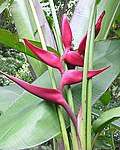 | Heliconia bourgaeana | S Mexico, Central America |
| Heliconia brachyantha | Panama, Colombia, Venezuela | |
| Heliconia brenneri | Ecuador | |
| Heliconia burleana | Colombia, Ecuador, Peru | |
| Heliconia caltheaphylla | Costa Rica | |
| Heliconia caquetensis | Colombia | |
| Heliconia carajaensis | Pará | |
| Heliconia caribaea | West Indies | |
| Heliconia carmelae | Colombia | |
 | Heliconia chartacea | N South America |
| Heliconia chrysocraspeda | Colombia | |
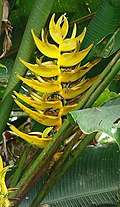 | Heliconia clinophila | Costa Rica, Panama |
| Heliconia colgantea | Costa Rica, Panama | |
| Heliconia collinsiana | S Mexico, Central America | |
| Heliconia combinata | Colombia | |
| Heliconia cordata | Colombia, Ecuador | |
| Heliconia crassa | Guatemala | |
| Heliconia cristata | Panama | |
| Heliconia cucullata | Costa Rica, Panama | |
| Heliconia curtispatha | Colombia, Ecuador, Central America | |
| Heliconia danielsiana | Costa Rica, Panama | |
| Heliconia darienensis | Colombia, Panama | |
| Heliconia dasyantha | Suriname, French Guiana | |
| Heliconia densiflora | Trinidad, N South America | |
| Heliconia dielsiana | NW South America | |
| Heliconia donstonea | Colombia, Ecuador | |
| Heliconia episcopalis | South America | |
| Heliconia estherae | Colombia | |
| Heliconia estiletioides | Colombia | |
| Heliconia excelsa | Napo | |
| Heliconia farinosa | SE Brazil, NE Argentina | |
| Heliconia faunorum | Panama | |
| Heliconia fernandezii | Antioquia, Colombia | |
| Heliconia × flabellata | Ecuador | |
| Heliconia foreroi | Colombia | |
| Heliconia fragilis | Colombia | |
| Heliconia fredberryana | Imbabura | |
| Heliconia fugax | Peru | |
| Heliconia gaiboriana | Los Ríos | |
| Heliconia gigantea | Colombia | |
| Heliconia gloriosa | Peru | |
| Heliconia gracilis | Costa Rica | |
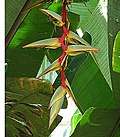 | Heliconia griggsiana | Colombia, Ecuador |
| Heliconia harlingii | Ecuador | |
| Heliconia hirsuta | Central + South America, Trinidad | |
| Heliconia holmquistiana | Colombia | |
| Heliconia huilensis | Colombia | |
| Heliconia ignescens | Costa Rica, Panama | |
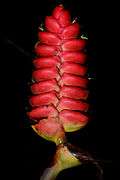 | Heliconia imbricata | Costa Rica, Panama, Colombia |
| Heliconia impudica | Ecuador | |
| Heliconia indica | Papuasia, Maluku | |
| Heliconia intermedia | Colombia | |
| Heliconia irrasa | Costa Rica, Panama, Nicaragua | |
| Heliconia julianii | N South America | |
| Heliconia juruana | Ecuador, Peru, NW Brazil | |
| Heliconia kautzkiana | Espírito Santo | |
| Heliconia lanata | Solomon Islands | |
| Heliconia lankesteri | Costa Rica, Panama | |
| Heliconia lasiorachis | Colombia, Peru, NW Brazil | |
| Heliconia latispatha | from S Mexico to Peru | |
| Heliconia laufao | Samoa | |
| Heliconia laxa | Colombia | |
| Heliconia lentiginosa | Antioquia | |
| Heliconia librata | S Mexico, Central America | |
| Heliconia lingulata | Peru, Bolivia | |
| Heliconia litana | Imbabura | |
| Heliconia longiflora | Colombia, Ecuador, Central America | |
| Heliconia longissima | Colombia | |
| Heliconia lophocarpa | Costa Rica, Panama | |
| Heliconia lourteigiae | South America | |
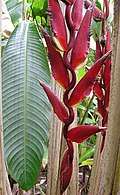 | Heliconia lozanoi | Colombia |
| Heliconia luciae | B Amazonas | |
| Heliconia lutea | Panama | |
| Heliconia luteoviridis | Colombia | |
| Heliconia lutheri | Ecuador | |
| Heliconia maculata | Panama | |
| Heliconia magnifica | Panama | |
| Heliconia × mantenensis | Minas Gerais | |
| Heliconia marginata | N South America, S Central America | |
| Heliconia mariae | NW South America, Central America | |
| Heliconia markiana | Ecuador | |
| Heliconia marthiasiae | S Mexico, Central America | |
| Heliconia meridensis | Colombia, Venezuela | |
| Heliconia metallica | N South America, Central America | |
| Heliconia monteverdensis | Costa Rica | |
| Heliconia mooreana | Guerrero | |
| Heliconia mucilagina | Colombia | |
| Heliconia mucronata | Venezuela, NW Brazil | |
| Heliconia mutisiana | Colombia | |
| Heliconia nariniensis | Colombia, Ecuador | |
| Heliconia necrobracteata | Panama | |
| Heliconia × nickeriensis | Suriname, French Guiana | |
| Heliconia nigripraefixa | Colombia, Ecuador, Panama | |
| Heliconia nitida | Colombia | |
| Heliconia nubigena | Costa Rica, Panama | |
| Heliconia nutans | Costa Rica, Panama | |
| Heliconia obscura | Ecuador, Peru | |
| Heliconia obscuroides | Colombia, Ecuador, Peru | |
| Heliconia oleosa | Colombia | |
| Heliconia ortotricha | Colombia, Ecuador, Peru | |
| Heliconia osaensis | Colombia, Central America | |
| Heliconia paka | Fiji | |
| Heliconia paludigena | Ecuador | |
| Heliconia papuana | New Guinea | |
| Heliconia pardoi | Ecuador | |
| Heliconia pastazae | Ecuador | |
| Heliconia peckenpaughii | Napo | |
| Heliconia pendula | Guiana, Fr Guiana, NE Brazil | |
| Heliconia penduloides | Peru | |
| Heliconia peteriana | Ecuador | |
| Heliconia × plagiotropa | Ecuador | |
| Heliconia platystachys | NW South America, S Central America | |
| Heliconia pogonantha | NW South America, S Central America | |
| Heliconia pruinosa | Peru | |
| Heliconia pseudoaemygdiana | Rio de Janeiro | |
| Heliconia psittacorum | N South America, Panama, Trinidad | |
| Heliconia ramonensis | Costa Rica, Panama | |
| Heliconia × rauliniana | Venezuela | |
| Heliconia regalis | Colombia, Ecuador | |
| Heliconia reptans | Colombia | |
| Heliconia reticulata | NW South America, S Central America | |
| Heliconia revoluta | Colombia, Venezuela, NW Brazil | |
| Heliconia rhodantha | Colombia | |
| Heliconia richardiana | NE South America | |
| Heliconia rigida | Colombia | |
| Heliconia riopalenquensis | Ecuador | |
| Heliconia rivularis | São Paulo, Brazil | |
| Heliconia robertoi | Colombia | |
| Heliconia robusta | Peru, Bolivia | |
| Heliconia rodriguensis | Venezuela | |
| Heliconia rodriguezii | Costa Rica | |
| Heliconia rostrata | Colombia, Ecuador, Peru, Bolivia | |
| Heliconia samperiana | Colombia | |
| Heliconia sanctae-martae | Sierra Nevada de Santa Marta | |
| Heliconia sanctae-theresae | Antioquia | |
| Heliconia santaremensis | Pará | |
| Heliconia sarapiquensis | Costa Rica, Panama | |
 | Heliconia scarlatina | Colombia, Panama, Peru |
| Heliconia schiedeana | Mexico | |
| Heliconia schumanniana | Colombia, Ecuador, Peru, N Brazil | |
| Heliconia sclerotricha | Ecuador | |
| Heliconia secunda | Costa Rica, Nicaragua | |
| Heliconia sessilis | Panama | |
| Heliconia signa-hispanica | Colombia | |
| Heliconia solomonensis | Solomon Islands, Bismarck Archipelago | |
| Heliconia spathocircinata | South America, Panama, Trinidad | |
| Heliconia spiralis | Colombia | |
| Heliconia spissa | S Mexico, Central America | |
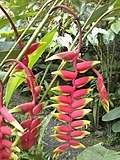 | Heliconia standleyi | Ecuador, Peru |
| Heliconia stella-maris | Colombia | |
| Heliconia stilesii | Costa Rica, Panama | |
| Heliconia stricta | N South America | |
| Heliconia subulata | South America | |
| Heliconia tacarcunae | Panama | |
| Heliconia talamancana | Costa Rica, Panama | |
| Heliconia tandayapensis | Ecuador | |
| Heliconia tenebrosa | Colombia, NE Peru, NW Brazil | |
| Heliconia terciopela | Colombia | |
| Heliconia thomasiana | Panama | |
| Heliconia timothei | NE Peru, NW Brazil | |
| Heliconia titanum | Colombia | |
| Heliconia tortuosa | S Mexico, Central America | |
| Heliconia trichocarpa | Costa Rica, Panama, Colombia | |
| Heliconia tridentata | Colombia | |
| Heliconia triflora | B Amazonas | |
| Heliconia umbrophila | Costa Rica | |
| Heliconia uxpanapensis | Veracruz | |
| Heliconia vaginalis | Costa Rica, Panama, Colombia, Ecuador | |
| Heliconia vellerigera | Ecuador, Peru | |
| Heliconia velutina | Colombia, Ecuador, Peru, NW Brazil | |
| Heliconia venusta | Colombia, Ecuador | |
| Heliconia villosa | Venezuela | |
| Heliconia virginalis | Ecuador | |
| Heliconia wagneriana | Central America, N South America, Trinidad | |
| Heliconia willisiana | Pichincha | |
| Heliconia wilsonii | Costa Rica, Panama | |
| Heliconia xanthovillosa | Panama | |
| Heliconia zebrina | Peru | |
Distribution and habitat
Most of the 194 known species[3] are native to the tropical Americas, but a few are indigenous to certain islands of the western Pacific and Maluku.[2] Many species of Heliconia are found in the tropical forests of these regions. Several species are widely cultivated as ornamentals, and a few are naturalized in Florida, Gambia and Thailand.[5]
Ecology
Heliconias are an important food source for forest hummingbirds, especially the hermits (Phathornithinae), some of which – such as the rufous-breasted hermit (Glaucis hirsuta) – also use the plant for nesting. The Honduran white bat (Ectophylla alba) also lives in tents it makes from heliconia leaves.
Bats
Pollination
Although Heliconia are almost exclusively pollinated by hummingbirds, some bat pollination has been found to occur. Heliconia solomonensis is pollinated by the macroglosine bat (Melonycteris woodfordi) in the Solomon Islands. Heliconia solomonensis has green inflorescences and flowers that open at night, which is typical of bat pollinated plants. The macroglosine bat is the only known nocturnal pollinator of Heliconia solomonensis.[14]
Habitat
Many bats use Heliconia leaves for shelter. The Honduran white bat, Ectohylla alba, utilizes five species of Heliconia to make diurnal tent-shaped roosts. The bat cuts the side veins of the leaf extending from the midrib, causing the leaf to fold like a tent. This structure provides the bat with shelter from rain, sun, and predators. In addition, the stems of the Heliconia leaves are not strong enough to carry the weight of typical bat predators, so shaking of the leaf alerts roosting bats to presence of predators.[15] The bats Artibeus anderseni and A. phaeotis form tents from the leaves of Heliconia in the same manner as the Honduran white bat.[16] The neotropical disk-winged bat, Thyroptera tricolor, has suction disks on the wrists which allow it to cling to the smooth surfaces of the Heliconia leaves. This bat roosts head-up in the rolled young leaves of Heliconia plants.[17]
Insects
Heliconias provide shelter for a diverse range of insects within their young rolled leaves and water-filled floral bracts. Insects that inhabit the rolled leaves often feed upon the inner surfaces of the leaf, such as beetles of the family Chrysomelidae. In bracts containing small amounts of water, fly larvae and beetles are the dominant inhabitants. In bracts with greater quantities of water the typical inhabitants are mosquito larva. Insects living in the bracts often feed on the bract tissue, nectar of the flower, flower parts, other insects, microorganisms, or detritus in the water contained in the bract (Siefert 1982). Almost all species of Hispini beetles that use rolled leaves are obligate herbivores of plants of the order of Zingiberales, which includes Heliconia. These beetles live in and feed from the rolled leaf, the stems, the inflorescences, or the unfurled mature leaves of the Heliconia plant. In addition, these beetles deposit their eggs on the leaf surface, petioles of immature leaves, or in the bracts of the Heliconia.[18] Furthermore, some wasp species such as Polistes erythrocephalus build their nest on the protected underside of large leaves.[19]
Hummingbirds
Hummingbirds are the main pollinators of heliconia flowers in many locations. The concurrent diversification of hummingbird-pollinated taxa in the order Zingiberales and the hummingbird family (Trochilidae: Phaethorninae) starting 18 million years ago supports the idea that these radiations have influenced one another through evolutionary time.[20][21] At La Selva Research Station in Costa Rica, specific species of Heliconia were found to have specific hummingbird pollinators.[22] These hummingbirds can be organized into two different groups: hermits and non-hermits. Hermits are the subfamily Phaethornithinae, consisting of the genera Anopetia, Eutoxeres, Glaucis, Phaethornis, Ramphodon, and Threnetes.[23] Non-hermits are a catch-all group of other hummingbirds that often visit heliconias, comprising several clades (McGuire 2008). Hermits are generally traplining foragers; that is, individuals visit a repeated circuit of high-reward flowers instead of holding fixed territories[22][24] Non-hermits are territorial over their Heliconia clumps, causing greater self-pollination.[22] Hermits tend to have long curved bills while non-hermits tend to possess short straight bills, a morphological difference that likely spurred the divergence of these groups in the Miocene era.[25][26] Characteristics of Heliconia flowers that select for either hermit or non-hermit pollinator specificity are degree of self-compatibility, flowering phenology, nectar production, color, and shape of flower.[27][28][25] The hummingbird itself will choose the plants its feeds from on the basis of its beak shape, its perch on the plant, and its territory choice.[29]
Hummingbird visits to the Heliconia flower do not affect its production of nectar.[30] This may account for the flowers not having a consistent amount of nectar produced from flower to flower.
Different Heliconia species have different flowering seasons. This suggests that the species compete for pollinators. Many species of Heliconia, even the newly colonized species, are visited by many different pollinators.[31]
Cultivation
Several cultivars and hybrids have been selected for garden planting, including:
- H. psittacorum × H. spathocircinata, both species of South America, mainly Brazil
- H. × rauliniana = H. marginata (Venezuela) × H. bihai (Brazil)
- H. chartacea cv. 'Sexy Pink'
Most commonly grown landscape Heliconia species include H. augusta, H. bihai, H. brasiliensis, H. caribaea, H. latispatha, H. pendula, H. psittacorum, H. rostrata, H. schiediana, and H. wagneriana.
Uses
Heliconias are grown for the florist's trade and as landscape plants. These plants do not grow well in cold, dry conditions. They are very drought intolerant, but can endure some soil flooding. Heliconias need an abundance of water, sunlight, and soils that are rich in humus in order to grow well. These flowers are grown in tropical regions all over the world as ornamental plants.[32] The flower of H. psittacorum (parrot heliconia) is especially distinctive, its greenish-yellow flowers with black spots and red bracts reminiscent of the bright plumage of parrots.
Gallery
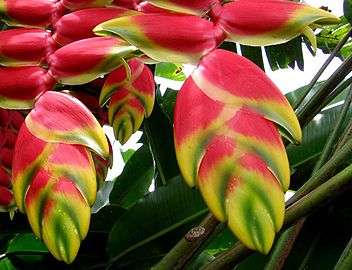 Heliconia rostrata in a botanical garden, Costa Rica
Heliconia rostrata in a botanical garden, Costa Rica Heliconia wagneriana in Florida
Heliconia wagneriana in Florida- Heliconia sp. in tropical rain forest at Sierra del Escambray, Cuba
- Heliconia sp. in tropical rain forest at Sierra del Escambray, Cuba

Heliconia stricta (Dwarf Jamaican) leaf at a nursery on Maui
See also
- National Tropical Botanical Garden, designated a conservation center by the Heliconia Society International
References
- Angiosperm Phylogeny Group (2009). "An update of the Angiosperm Phylogeny Group classification for the orders and families of flowering plants: APG III". Botanical Journal of the Linnean Society. 161 (2): 105–121. doi:10.1111/j.1095-8339.2009.00996.x. Archived from the original (PDF) on 2017-05-25. Retrieved 2013-06-26.
- Kew World Checklist of Selected Plant Families
- Christenhusz, M. J. M.; Byng, J. W. (2016). "The number of known plants species in the world and its annual increase". Phytotaxa. Magnolia Press. 261 (3): 201–217. doi:10.11646/phytotaxa.261.3.1.
- "Helliconia". IUCN Red List of Threatened Species. Retrieved 17 October 2019.
- Kew World Checklist of Selected Plant Families, genus Heliconia
- Berry, Fred; Kress, John (1991). Heliconia Identification Guide. Smithsonian Institution Press.
- Gilman, Edward; Meerow, Alan (1 May 2007). "Heliconia spp. Heliconia". University of Florida IFAS Extension.
- He, J.; Chee, C.; Goh, C. (1996). "'Photoinhibition' of Heliconia under natural tropical conditions: the importance of leaf orientation for light interception and leaf temperature". Plant, Cell & Environment. 19 (11): 1238–1248. doi:10.1111/j.1365-3040.1996.tb00002.x.
- Bruna, E. M.; Kress, W. J.; Marques, F.; da Silva, O. F. (2004). "Heliconia acuminata reproductive success is independent of local floral density". Acta Amazonica. 34 (3): 467–471. doi:10.1590/s0044-59672004000300012.
- Uriarte, M. Anciães; da Silva, M. T.B.; Rubim, P.; Johnson, E.; Bruna, E. M. (2011). "Disentangling the drivers of reduced long-distance seed dispersal by birds in an experimentally fragmented landscape". Ecology. 92 (4): 924–937. doi:10.1890/10-0709.1.
- Hoii, Karen; Lulow, Megan (2006). "Effects of species, habitat, and distance from edge on post-dispersal seed predation in a Tropical Rainforest". Biotropica. 29 (4): 459–468. doi:10.1111/j.1744-7429.1997.tb00040.x.
- Walter Judd; et al. (2007). Plant Systematics: A phylogenetic approach (3rd ed.). Sunderland: Sinauer Associates, Inc.
- Sass et al 2016.
- Kress, W. J. (1985). "Bat Pollination of an Old World Heliconia". Biotropica. 17 (4): 302–308. doi:10.2307/2388592. JSTOR 2388592.
- Timm, R.W.; Mortimer, J. (1976). "Selection of Roost sited by Honduran White Bats, Ectophylla Alba (Chiroptera: Phyllostomatidae)" (PDF). Ecology. 57 (2): 385–389. doi:10.2307/1934829. hdl:1808/4484. JSTOR 1934829.
- Timm, R.W.; Patterson, B.D. (1987). "Tent Construction by bats of the genera Artibeus and Uroderma". Fieldiana: Zoology. 29: 188–212.
- Findley, J.S.; Wilson, D.E. (1974). "Observations on the Neotropical disk-winged bat, Thyroptera tricolor spix". Journal of Mammalogy. 55 (3): 563–571. doi:10.2307/1379546. JSTOR 1379546. PMID 4853410.
- Strong Jr., Donald R. (1977). "Insect Species Richness: Hispine Beetles of the Heliconia Latispatha". Ecology. 58 (3): 573–582. doi:10.2307/1939006. JSTOR 1939006.
- "Nesting habits and nest symbionts of Polistes erythrocephalus Latreille (Hymenoptera Vespidae) in Costa Rica" (PDF). Retrieved 14 October 2014.
- Bleiweiss, R. (1998). "Tempo and mode of hummingbird evolution". Biological Journal of the Linnean Society. 65 (1): 63–76. doi:10.1111/j.1095-8312.1998.tb00351.x.
- Kress, W.J.; Specht, Chelsea (2005). "Between cancer and capricorn: phylogeny, evolution, and ecology of the tropical Zingiberales". Proceedings of a Symposium on Plant Diversity and Complexity Patterns - Local, Regional and Global Dimensions. 55: 459–478.
- Stiles, Gary (1975). "Ecology, flowering phenology, and hummingbird pollination of some Costa Rican "Heliconia" species". Ecology. 56 (2): 285–301. doi:10.2307/1934961. JSTOR 1934961.
- McGuire, J. A.; Witt, C. C.; Remsen Jr., J. V.; Dudley, R.; Altshuler, D.L. (2008). "A higher-level taxonomy for hummingbirds". Journal of Ornithology. 150: 155–165. doi:10.1007/s10336-008-0330-x.
- Dobkin, D. S. (1984). "Flowering patterns of long-lived "Heliconia" inflorescences: implications for visiting and resident nectarivores". Oecologia. 64 (2): 245–254. Bibcode:1984Oecol..64..245D. doi:10.1007/bf00376878. PMID 28312346.
- Graham, C. H.; Parra, J. L.; Rahbek, C.; McGuire, J. A. (2009). "Phylogenetic structure in tropical hummingbird communities". Proceedings of the National Academy of Sciences of the United States of America. 106 (Suppl 2): 19673–19678. doi:10.1073/pnas.0901649106. PMC 2780942. PMID 19805042.
- Temeles, E. J.; Miller, J. S.; Rifkin, J. L. (2010). "Evolution of sexual dimorphism in bill size and shape of hermit hummingbirds (Phaethornithinae): a role for ecological causation". Philosophical Transactions of the Royal Society. 365 (1543): 1053–1063. doi:10.1098/rstb.2009.0284. PMC 2830232. PMID 20194168.
- Kress, W. J.; Specht, C. D. (2005). "Between Cancer and Capricorn: phylogeny, evolution and ecology of the primarily tropical Zingiberales". Biologiske Skrifter. 55: 459–478.
- Meléndez-Ackerman, E. J.; Speranza, P.; Kress, W. J.; Rohena, L.; Toledo, E.; Cortés, C.; Treece, D.; Gitzendanner, M.; Soltis, P.; Soltis, D. (2005). "Microevolutionary processes inferred from AFLP and morphological variation in Heliconia bihai (Heliconiaceae)". International Journal of Plant Sciences. 166 (5): 781–794. doi:10.1086/431231.
- Linhart, Yan (1973). "Ecological and behavioral determinants of pollen dispersal in hummingbird- pollinated Heliconia". The American Naturalist. 107 (956): 511–523. doi:10.1086/282854.
- Feinsinger, Peter (1983). "Variable nectar secretion in a Heliconia species pollinated by hermit hummingbirds". Biotropica. 15 (1): 48–52. doi:10.2307/2387998. JSTOR 2387998.
- Feinsinger, Peter (1978). "Ecological interactions between plants and hummingbirds in a successional tropical community". Ecological Monographs. 48 (3): 269–287. doi:10.2307/2937231. JSTOR 2937231.
- Ong, Chong Ren (March 2007). "Heliconia Basics". Green Culture Singapore.
Bibliography
- Iles, William J.D.; Sass, Chodon; Lagomarsino, Laura; Benson-Martin, Gracie; Driscoll, Heather; Specht, Chelsea D. (December 2016). "The phylogeny of Heliconia (Heliconiaceae) and the evolution of floral presentation". Molecular Phylogenetics and Evolution. 117: 150–167. doi:10.1016/j.ympev.2016.12.001.
- Sass, C; Iles, WJ; Barrett, CF; Smith, SY; Specht, CD (21 January 2016). "Revisiting the Zingiberales: using multiplexed exon capture to resolve ancient and recent phylogenetic splits in a charismatic plant lineage". PeerJ. 4: e1584. doi:10.7717/peerj.1584. PMC 4727956. PMID 26819846.